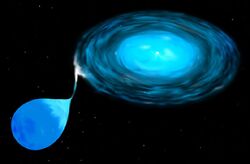Astronomy:ZTF J1813+4251
From HandWiki
Short description: Stellar binary star system
| Observation data Equinox J2000.0]] (ICRS) | |
|---|---|
| Constellation | Hercules |
| Right ascension | 18h 13m 11.13s[1] |
| Declination | 42° 51′ 50.4″[1] |
| Apparent magnitude (V) | 18.72[2] |
| Astrometry | |
| Radial velocity (Rv) | 461.3[1] km/s |
| Proper motion (μ) | RA: −12.317[3] mas/yr Dec.: −2.656[3] mas/yr |
| Parallax (π) | 1.1975 ± 0.1551[3] mas |
| Distance | approx. 2,700 ly (approx. 800 pc) |
| Orbit[1] | |
| Period (P) | 51.16 min |
| Semi-major axis (a) | 0.4 R☉ |
| Eccentricity (e) | 0 (fixed) |
| Inclination (i) | 78.80° |
| Semi-amplitude (K2) (secondary) | 461.3 km/s |
| Details[1] | |
| White Dwarf | |
| Mass | 0.562±0.015 M☉ |
| Radius | 0.01374±0.00023 R☉ |
| Surface gravity (log g) | 7.9 cgs |
| Temperature | 12600±500 K |
| Donor | |
| Mass | 0.1185±0.0067 M☉ |
| Radius | 0.1017±0.0019 R☉ |
| Surface gravity (log g) | 5.43 cgs |
| Temperature | 6000±80 K |
| Rotational velocity (v sin i) | 145 km/s |
| Other designations | |
ZTF J1813+4251, Gaia DR3 2113285228603943168 | |
| Database references | |
| SIMBAD | data |
ZTF J1813+4251 is a binary star system including a star and white dwarf, co-orbiting every 51 minutes, about 3,000 light years away in the constellation of Hercules. It is considered a cataclysmic variable with the white dwarf pulling outer layers of hydrogen from the star onto itself. It has the shortest orbital period of all hydrogen-rich cataclysmic variable stars known. It is predicted that the orbital period will reach a minimum of 18 minutes within 75 million years as the system evolves.[1]

An example artistic impression of a cataclysmic variable star binary
It was identified in 2022 by Kevin Burdge of MIT using a computer algorithm that searched over 1,000 images from the Zwicky Transient Facility, identifying stars that had brightness variability periods around one hour.
References
- ↑ 1.0 1.1 1.2 1.3 1.4 1.5 1.6 , Wikidata Q114815846
- ↑ Lasker, Barry M. et al. (August 2008). "The Second-Generation Guide Star Catalog: Description and Properties". The Astronomical Journal 136 (2): 735–766. doi:10.1088/0004-6256/136/2/735. Bibcode: 2008AJ....136..735L.
- ↑ 3.0 3.1 3.2 Vallenari, A. et al. (2022). "Gaia Data Release 3. Summary of the content and survey properties". Astronomy & Astrophysics. doi:10.1051/0004-6361/202243940 Gaia DR3 record for this source at VizieR.
External links
- Astronomers find a “cataclysmic” pair of stars with the shortest orbit yet
- Scientists spot ‘cataclysmic star pair’ whirring around each other in spectacular dance
- "Cataclysmic" Pair Of Stars With Shortest Known Orbit Discovered
- Two Stars Orbiting Each Other Every 51 Minutes. This Can’t End Well
 |


